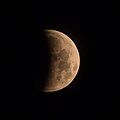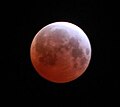April 2015 lunar eclipse
| Total eclipse | |||||||||||||||||
 Los Angeles, California, 12:00 UTC | |||||||||||||||||
| Date | 4 April 2015 | ||||||||||||||||
|---|---|---|---|---|---|---|---|---|---|---|---|---|---|---|---|---|---|
| Gamma | 0.4460 | ||||||||||||||||
| Magnitude | 1.0008 | ||||||||||||||||
| Saros cycle | 132 (30 of 71) | ||||||||||||||||
| Totality | 4 minutes, 43 seconds | ||||||||||||||||
| Partiality | 209 minutes, 1 seconds | ||||||||||||||||
| Penumbral | 357 minutes, 31 seconds | ||||||||||||||||
| |||||||||||||||||
A total lunar eclipse took place on 4 April 2015. It is the former of two total lunar eclipses in 2015, and the third in a tetrad (four total lunar eclipses in series). Other eclipses in the tetrad are those of 15 April 2014, 8 October 2014, and 28 September 2015.
This is the 30th member of Lunar Saros 132, and the first total eclipse. The previous event was the March 1997 lunar eclipse, being slightly partial.
Duration[edit]
Totality lasted only 4 minutes and 43 seconds,[1] making it the shortest lunar totality in almost five centuries since 17 October 1529 (which lasted 1 minute and 42 seconds). It was claimed by some that due to the oblateness of the Earth, it may have actually just been a partial eclipse.[2] It was the sixth total lunar eclipse out of nine with totality under 5 minutes in a five millennium period between 2,000 BC and 3,000 AD. The eclipsed moon was 12.9% smaller in apparent diameter than the supermoon September 2015 lunar eclipse, measured as 29.66' and 33.47' in diameter from the center of the Earth. It occurred 3 days past apogee at 29.42'.
Visibility[edit]
The eclipse was visible across the Pacific, including all of Australia and New Zealand. It was visible near sunrise for North America, and after sunset for eastern Asia including India.
 
|
 Visibility map |
Background[edit]
A lunar eclipse occurs when the Moon passes within Earth's umbra (shadow). As the eclipse begins, Earth's shadow first darkens the Moon slightly. Then, the shadow begins to "cover" part of the Moon, turning it a dark red-brown color (typically - the color can vary based on atmospheric conditions). The Moon appears to be reddish because of Rayleigh scattering (the same effect that causes sunsets to appear reddish) and the refraction of that light by Earth's atmosphere into its umbra.[3]
The following simulation shows the approximate appearance of the Moon passing through Earth's shadow. The Moon's brightness is exaggerated within the umbral shadow. The southern portion of the Moon will be closest to the center of the shadow, making it darkest, and most red in appearance.
Gallery[edit]
 Progression from Bali, Indonesia | |
 Time-lapsed image from Taiwan |
 Sequence from Fox Observatory in Sunrise, Florida |
 Sequence from Melbourne, Florida |
 Progression from St. Louis, Missouri |
-
Toronto, Canada, 9:54 UTC
-
Auckland, New Zealand, 9:54 UTC
-
Macon, Georgia, 10:54 UTC
-
Mexico City, Mexico, 10:59 UTC
-
Minneapolis, Minnesota, 11:09 UTC
-
Chicago, Illinois, 11:36 UTC
-
Melbourne, Australia, 11:46 UTC
-
Denver, Colorado, 11:50 UTC
-
Tai Po, Hong Kong, 12:01 UTC
-
Santa Clara County, California, 12:02 UTC
-
Las Vegas, Nevada, 12:03 UTC
-
Rio Rancho, New Mexico, 12:13 UTC
-
Bangkok, Thailand, 12:37 UTC
-
Hirosaki, Aomori, 12:56 UTC
-
Pune, India, 13:38 UTC
Timing[edit]
| Time Zone adjustments from UTC |
+8h | +11h | +13h | -10h | -8h | -7h | -6h | -5h | -4h | ||||
|---|---|---|---|---|---|---|---|---|---|---|---|---|---|
| AWST | AEDT | NZDT | HST | AKDT | PDT | MDT | CDT | EDT | |||||
| Event | Evening April 4 | Morning April 4 | |||||||||||
| P1 | Penumbral begins | N/A† | 8:01 pm | 10:01 pm | 11:01 pm | 1:01 am | 2:01 am | 3:01 am | 4:01 am | 5:01 am | |||
| U1 | Partial begins | 6:16 pm | 9:16 pm | 11:16 pm | 12:16 am | 2:16 am | 3:16 am | 4:16 am | 5:16 am | 6:16 am | |||
| U2 | Total begins | 7:58 pm | 10:58 pm | 12:58 am | 1:58 am | 3:58 am | 4:58 am | 5:58 am | 6:58 am | Set | |||
| Greatest eclipse | 8:00 pm | 11:00 pm | 1:00 am | 2:00 am | 4:00 am | 5:00 am | 6:00 am | 7:00 am | Set | ||||
| U3 | Total ends | 8:03 pm | 11:03 pm | 1:03 am | 2:03 am | 4:03 am | 5:03 am | 6:03 am | Set | Set | |||
| U4 | Partial ends | 9:45 pm | 12:45 am | 2:45 am | 3:45 am | 5:45 am | Set | Set | Set | Set | |||
| P4 | Penumbral ends | 10:59 pm | 1:59 am | 3:59 am | 3:59 am | 5:59 am | Set | Set | Set | Set | |||
† The Moon was not visible during this part of the eclipse in this time zone.

The timing of total lunar eclipses are determined by its contacts:[4]
|
Related eclipses[edit]
Eclipses of 2015[edit]
- A total solar eclipse on 20 March.
- A total lunar eclipse on 4 April.
- A partial solar eclipse on 13 September.
- A total lunar eclipse on 28 September.
Half-Saros cycle[edit]
A lunar eclipse will be preceded and followed by solar eclipses by 9 years and 5.5 days (a half saros).[5] This lunar eclipse is related to two total solar eclipses of solar saros 139.
| 29 March 2006 | 8 April 2024 |
|---|---|

|

|
Lunar year series[edit]
The eclipse is the one of four lunar eclipses in a short-lived series at the ascending node of the Moon's orbit.
The lunar year series repeats after 12 lunations, or 354 days (shifting back about 10 days in sequential years). Because of the date shift, the Earth's shadow will be about 11 degrees west in sequential events.
| Lunar eclipse series sets from 2013–2016 | ||||||||
|---|---|---|---|---|---|---|---|---|
| Ascending node | Descending node | |||||||
| Saros | Viewing date |
Type | Gamma | Saros | Viewing date |
Type | Gamma | |
112
|
2013 Apr 25
|
Partial
|
−1.0121 | 117
|
2013 Oct 18
|
Penumbral
|
1.1508 | |
122
|
2014 Apr 15
|
Total
|
−0.3017 | 127
|
2014 Oct 08
|
Total
|
0.3827 | |
132
|
2015 Apr 04
|
Total
|
0.4460 | 137
|
2015 Sep 28
|
Total
|
−0.3296 | |
| 142 | 2016 Mar 23
|
Penumbral
|
1.1592 | 147
|
2016 Sep 16
|
Penumbral
|
−1.0549 | |
| Last set | 2013 May 25 | Last set | 2012 Nov 28 | |||||
| Next set | 2017 Feb 11 | Next set | 2016 Aug 18 | |||||
Saros series[edit]
Lunar saros series 132, repeating every 18 years and 11 days, has a total of 71 lunar eclipse events including 44 umbral lunar eclipses (32 partial lunar eclipses and 12 total lunar eclipses).
| Greatest | First | |||
|---|---|---|---|---|
 The greatest eclipse of the series will occur on 2123 Jun 9, lasting 106 minutes.[6] |
Penumbral | Partial | Total | Central |
1492 May 12
|
1636 Aug 16
|
2015 Apr 4
|
2069 May 6
| |
| Last | ||||
| Central | Total | Partial | Penumbral | |
2177 Jul 11
|
2213 Aug 2
|
2429 Dec 11
|
2754 Jun 26
| |
There are 11 series events between 1901 and 2100, grouped into threes (called an exeligmos), each column with approximately the same viewing longitude on earth.
| 1907 Jan 29 | 1925 Feb 8 | 1943 Feb 20 | |||

|

|

|

|

|

|
| 1961 Mar 2 | 1979 Mar 13 | 1997 Mar 24 | |||

|

|

|

|

|

|
| 2015 Apr 4 | 2033 Apr 14 | 2051 Apr 26 | |||

|

|

|

|

|

|
| 2069 May 6 | 2087 May 17 | ||||

|

|

|

| ||
Tzolkinex[edit]
- Preceded: Lunar eclipse of February 20-21, 2008
- Followed: Lunar eclipse of May 15-16, 2022
See also[edit]
Notes[edit]
- ^ Espenak, Fred. "Total Lunar Eclipse of 2015 Apr 04" (PDF). NASA's GSFC.
- ^ "The Lunar Eclipse Wasn't Total After All?!". Sky & Telescope. 6 April 2015.
- ^ Fred Espenak and Jean Meeus. "Visual Appearance of Lunar Eclipses". NASA. Retrieved 13 April 2014.
- ^ Clarke, Kevin. "On the nature of eclipses". Inconstant Moon. Cyclopedia Selenica. Retrieved 19 December 2010.
- ^ Mathematical Astronomy Morsels, Jean Meeus, p.110, Chapter 18, The half-saros
- ^ Listing of Eclipses of series 132
External links[edit]
- 2015 Apr 04 chart: Eclipse Predictions by Fred Espenak, NASA/GSFC
- Hermit Eclipse: Total Lunar Eclipse: April 4, 2015
- Mattastro.com Total Lunar Eclipse: April 4, 2015
- Full Moon in Earth's Shadow APOD 2015 April 8




















